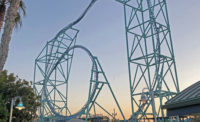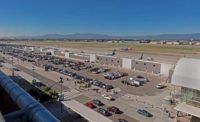From skyscrapers in San Francisco and Los Angeles to high-technology facilities, Hathaway Dinwiddie Construction Co. has earned a reputation for taking on tough jobs during its 100 years in California. HDCCo delivered the Russ Building in 1927—the tallest building in San Francisco at the time—and San Francisco’s iconic Transamerica Pyramid in 1972. It is currently at work on the 1,070-ft-tall Salesforce Tower, which aims to be the city’s tallest when complete in 2018.
Though HDCCo has earned a reputation for building skyscrapers, recent portfolio diversity has cemented its success. Through a deliberate and focused strategy to establish itself in multiple market sectors, the company has tallied remarkable revenue jumps—all in California. In light of its smart growth strategies and continued delivery of notable projects throughout the state, ENR California named Hathaway Dinwiddie its 2016 Contractor of the Year.
Big projects mean big revenues. In addition to the $1-billion Salesforce Tower project—a joint venture with Clark Construction—HDCCo is building the 1-million-sq-ft Cove at Oyster Bay biotechnology campus in South San Francisco; the 1-million-sq-ft $485-million Exchange on 16th, a high-tech development in Mission Bay; and the $700-million USC Village project at the University of Southern California in Los Angeles.
The returns are starting to show up on its balance sheet. In 2015, the company’s revenue rose 64%, reaching $1.14 billion—up from $696 million in 2014 and $684 million in 2013.
“We’ve been blessed over the decades with being associated with exciting, sophisticated and complex work—and some important architectural work,” says Greg Cosko, HDCCo’s president and CEO. “There continue to be significant large-project opportunities, including some among our very good existing clients …. We want to be the go-to guys for tough, sophisticated projects.”
The firm’s strategy banks heavily on work with repeat clients and selective pursuit of new ones. Last year, seven of the company’s top 10 revenue projects were with repeat clients—and four of the top five projects were for clients that it has worked with for decades.
Though the firm is seen as a well-established contractor in the state, its track record on complex projects helps it maintain a reputation for being a cutting-edge builder. “We’ve been really diligent about maintaining our integrity and maintaining commitment to long-standing corporate customers in our regions, but we’re also very strong in the tech market,” says Ed Conlon, senior vice president in the Northern California region. “We’ve been able to ride the wave with companies like Salesforce, Twitter, Pinterest and Amazon.”
Conlon credits the company’s recent success to its ability to diversify. The company as its known today was the result of the merger of Dinwiddie and E.A. Hathaway in 1996. While Dinwiddie was well known for its work on high-rises and iconic buildings such as the Getty Center in Los Angeles, E.A. Hathaway brought experience as a technical builder, including health care and laboratory work. After the merger, HDCCo continued to diversify, expanding into higher education, technology and life sciences markets.
“In the last 10 years, we’ve positioned ourselves so that now the market has come to us,” Conlon says. “We’ve been very purposeful and strategic. When markets waned, we didn’t blink; we maintained our focus. When the market came back, we were well-positioned.”
The company’s strategy has paid off with clients like USC. For more than a decade, the firm has been a constant presence on the campus, building numerous projects including the School of Cinematic Arts, the Dana and David Dornsife Cognitive Neuroscience Imaging Center and the ongoing USC Village project—a 2-million-sq-ft mixed-use residential, retail and academic development.
One of the firm’s most successful traits is its ability to “see the big picture” on campus, says Willy Marsh, USC’s director of capital construction development.
“They see and understand how the institution operates,” he adds. “They’ve been able to embrace it and be successful here.
“We’ve had contractors come in and go out quickly. Those kinds of contractors just try to protect the dollar. [Hathaway Dinwiddie] focuses on the project and delivering for us. That’s why they get our repeat business.”
Strong track records have also helped feed its interiors and tenant improvement work. Cosko says the firm typically earns 25% of its revenue from its special projects group, which includes interiors, renovations, repositioning and seismic upgrades. For example, since building the Transamerica Building 44 years ago, HDCCo has consistently performed the tenant improvements.
The contractor has also established a strong record among architecture firms, often being called in to take on challenging projects. “We frequently recommend them because they are committed to quality, and we know what it will be like working with them,” says Jeffrey Heller, founding principal of Heller Manus Architects, who has worked with the contractor for more than three decades, including its current 350 Bush Street and 500 Pine Street office projects in San Francisco.
“They always work with you as a team,” he adds. “There’s never been the finger-pointing kind of relationship that can happen on projects, even on tough issues. That’s quite unique.”
It’s been Heller’s experience that with most contractors, there’s always a level of contention during a job. “With them, their culture is such that, everyone is highly productive,” he says. “That always leads to a great result.”
Those kinds of recommendations pay dividends, especially when HDCCo goes up against larger national competitors. Though it focuses entirely on California, the firm often competes against some of the largest contractors in the U.S.
“We feel that being local gives us an advantage,” says Arthur Kozinski, senior vice president in the Southern California region. “We see the firms come and go, usually because they don’t have familiarity with the regions in things like earthquake codes and the jurisdictions.”
“You need to have local resources and relationships,” Conlon adds. “I don’t even know how [the large national contractors] do it. Our margins are already tight, and you have to rely on your resources. That’s the only way to maintain the level of quality we expect.”
Employee retention is also critical for maintaining consistency and quality, Cosko says. Though demand for talent is high in California, especially in the Bay Area, he says the firm’s annual turnover rate is less than 5%.
“Loyalty is at the core of our culture,” he says. “People stay because we consistently engage in inspiring work and they see opportunities for growth. They see a future here.”
Kozinski, with HDCCo for 26 years, adds that the firm has a very entrepreneurial culture. “If you’re good at what you do, you’re performance-based and you have good ethics, you can make a career here,” he says.
Cosko says the company’s commitment to sustainability and its adoption of technology has also helped it attract talent. LEED Accredited Professionals make up more than 35% of the staff. By the end of the year, Hathaway Dinwiddie will have completed 14 LEED Platinum buildings. The firm derived $778 million of its 2015 revenue from green-building projects.
Cosko sees the firm continuing on its current course. “What I see is much of the same: inspiring projects, developing our workforce and strengthening our future on a bedrock of financial stability and service.”
Still, as a 100-year-old firm, Cosko stresses the need to avoid stagnating and keep evolving. “We’re now entering into a fresh round of strategic planning, evaluating our identity and our presence in the market,” he says. “We’re always looking at staying relevant.”







Post a comment to this article
Report Abusive Comment